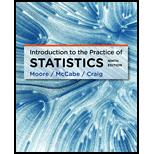
(a)
To test: Whether an 80% confidence interval would be wider or narrower than the 95% confidence interval obtained in Exercise 8.33.
(a)
Answer to Problem 34E
Solution: The 80% confidence interval would be narrower. An 80% confidence interval is obtained as
Explanation of Solution
Calculation: The 95% confidence interval is obtained as
The formula for 80% confidence interval for population proportion p is defined as:
Where,
The sample proportion is provided as:
Therefore, the sample proportion
The formula for margin of error m is defined as:
In the above formula,
The formula for standard error
The sample proportion
Therefore, the standard error is obtained as 0.0131. The value of
So, the margin of error is obtained as:
Therefore, the margin of error is obtained as 0.016768.
Substitute the obtained values of margin of error and sample proportion in the formula for confidence interval. Therefore, an 80% confidence interval is obtained as:
Therefore, an 80% confidence interval is obtained as
The width of the 80% confidence interval is obtained as:
The width of the 95% confidence interval is obtained as:
Conclusion: The obtained widths of the two confidence levels show that the 80% confidence interval is narrower than the 95% confidence interval.
(b)
To test: Whether a 98% confidence interval would be wider or narrower than the 95% confidence interval obtained in Exercise 8.33.
(b)
Answer to Problem 34E
Solution: A 98% confidence interval would be wider. A 98% confidence interval is obtained as
Explanation of Solution
Calculation: The 95% confidence interval is obtained as
The formula for 98% confidence interval for p is defined as:
The sample proportion is provided as:
Therefore, the sample proportion
The formula for margin of error m is defined as:
In the above formula,
The formula for standard error
The sample proportion
Therefore, the standard error is obtained as 0.0131. The value of
So, the margin of error is obtained as:
Therefore, the margin of error is obtained as 0.030523.
Substitute the obtained values of margin of error and sample proportion in the formula for confidence interval. Therefore, a 98% confidence interval is obtained as:
Therefore, a 98% confidence interval is obtained as
The width of the 98% confidence interval is obtained as:
The width of the 95% confidence interval is obtained as:
Conclusion: The obtained widths of the two confidence levels show that 98% confidence interval is wider than the 95% confidence interval.
Want to see more full solutions like this?
Chapter 8 Solutions
Introduction to the Practice of Statistics
 MATLAB: An Introduction with ApplicationsStatisticsISBN:9781119256830Author:Amos GilatPublisher:John Wiley & Sons Inc
MATLAB: An Introduction with ApplicationsStatisticsISBN:9781119256830Author:Amos GilatPublisher:John Wiley & Sons Inc Probability and Statistics for Engineering and th...StatisticsISBN:9781305251809Author:Jay L. DevorePublisher:Cengage Learning
Probability and Statistics for Engineering and th...StatisticsISBN:9781305251809Author:Jay L. DevorePublisher:Cengage Learning Statistics for The Behavioral Sciences (MindTap C...StatisticsISBN:9781305504912Author:Frederick J Gravetter, Larry B. WallnauPublisher:Cengage Learning
Statistics for The Behavioral Sciences (MindTap C...StatisticsISBN:9781305504912Author:Frederick J Gravetter, Larry B. WallnauPublisher:Cengage Learning Elementary Statistics: Picturing the World (7th E...StatisticsISBN:9780134683416Author:Ron Larson, Betsy FarberPublisher:PEARSON
Elementary Statistics: Picturing the World (7th E...StatisticsISBN:9780134683416Author:Ron Larson, Betsy FarberPublisher:PEARSON The Basic Practice of StatisticsStatisticsISBN:9781319042578Author:David S. Moore, William I. Notz, Michael A. FlignerPublisher:W. H. Freeman
The Basic Practice of StatisticsStatisticsISBN:9781319042578Author:David S. Moore, William I. Notz, Michael A. FlignerPublisher:W. H. Freeman Introduction to the Practice of StatisticsStatisticsISBN:9781319013387Author:David S. Moore, George P. McCabe, Bruce A. CraigPublisher:W. H. Freeman
Introduction to the Practice of StatisticsStatisticsISBN:9781319013387Author:David S. Moore, George P. McCabe, Bruce A. CraigPublisher:W. H. Freeman





